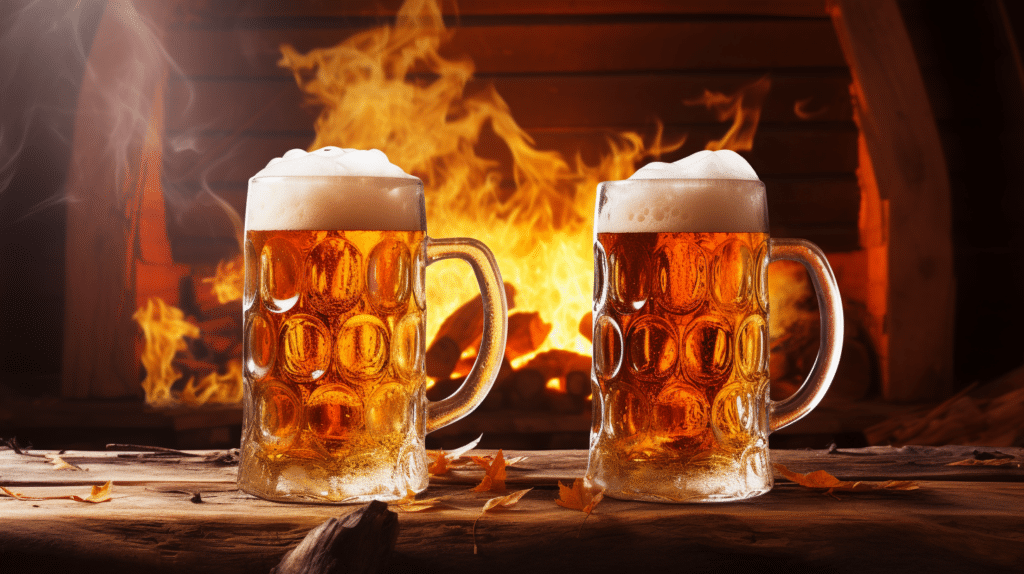Disclaimer: This post may contain affiliate links, from which I may earn a small commission at no extra cost to you. Thank you for supporting Ale Affair.
Discover the intriguing world of warm beers, a subject steeped in cultural heritage and rife with misconceptions. Across the globe, the preferred temperature of this beloved brew sparks lively debates and reflects deep-seated traditions. Do Germans drink warm beer? This post sheds light on the global customs surrounding warm beers, dispelling myths and revealing the true preferences of beer enthusiasts from Germany to the United Kingdom. Join us as we unravel the facts and challenge the unfounded notions about this tipple’s tepid temperatures, setting the stage for an enlightening journey into the heart of beer culture.
Do Germans Drink Warm Beer?
The idea that Germans prefer to drink warm beer is a misconception. In Germany, beer is typically served at a temperature that best accentuates its flavours, which often means cooler than “room temperature” but not as cold as it is commonly served in some other countries like the United States. The exact serving temperature can vary depending on the type of beer. For example:
- Light beers, such as Pilsners, are usually served chilled, around 6-8°C (43-46°F).
- Wheat beers might be served slightly warmer than light lagers, around 8-10°C (46-50°F).
- Darker beers, like Bocks or Schwarzbiers, are often served at slightly warmer temperatures than lighter beers but still cooler than room temperature, around 9-13°C (48-55°F).
The tradition of serving beer at these temperatures is tied to the characteristics of the beer. Cooler temperatures can be refreshing and help maintain the fizziness of the beer, while slightly warmer temperatures than what is typical in the U.S. can enhance the beer’s aroma and flavour profile, particularly for complex brews.
While Germans do not generally drink their beer “warm” by any standard, they may enjoy it at temperatures that are warmer than what is common in American bars and restaurants but still cool enough to be refreshing and to optimally present the beer’s flavours.
What is Hot Beer Called in Germany?
In Germany, a beverage known as “Glühbier,” which translates to “glow beer” or “mulled beer,” is similar to the concept of hot beer. Glühbier is essentially a winter drink, akin to the more widely known “Glühwein” (mulled wine), and is made by warming beer and adding spices such as cloves, cinnamon, star anise, and sometimes citrus. It’s a seasonal speciality, often found at Christmas markets and winter festivals throughout Germany and some other parts of Europe.
The idea is to offer a warming, spiced drink that has the malty base of beer instead of wine. While not as universally popular as Glühwein, Glühbier provides an alternative for beer lovers during the colder months, combining the comforting warmth of a hot drink with the familiar taste of beer, enriched with seasonal spices.
The tradition of warming beer dates back to the Middle Ages and possibly even earlier. Medieval Europeans often drank their beer warm or at room temperature, and adding spices to beer was common to enhance its flavour and, in some beliefs, to offer health benefits.
Global Beer Temperatures: What Nationality Drink Warm Beer?

We’ve answered the question, “Do Germans drink warm beer?”, but, what about other nationalities?
The concept of drinking warm beer isn’t tied to a specific nationality as a widespread practice, but rather, it varies based on cultural traditions, historical practices, and individual preferences. The perception of what constitutes “warm” beer can also differ. Here are a few instances where warmer beer is enjoyed, reflecting a range of traditions and preferences across different cultures:
The British Isles, renowned for their cask ales and stouts, hold the flag high for warm beer. Here, ‘warm’ translates to cellar temperature, around 50-55°F (10-13°C), which is considered just right for unlocking the depth of flavour that characterises British ales. The gentle chill allows the subtleties of malt and hops to shine, making each sip a discovery of the brewer’s art.
Europe’s heartland also cherishes its beer slightly warmed. Belgium, with its illustrious array of Trappist ales and hearty dubbels, and Austria, known for its Märzen and Dopplebocks, serve their brews at temperatures that might surprise the uninitiated. Rather than stifling the beer’s character with a frosty temperature, these countries prefer a warmer serve to enhance the beer’s inherent qualities.
Countries in Eastern Europe, such as Poland, have a tradition of drinking mulled beer, similar to the German Glühbier. This involves heating beer and adding spices, much like mulled wine and is particularly popular during the winter months.
These examples show that while the consumption of warm beer is not a widespread practice associated with any one nationality, there are cultural pockets and traditions around the world where warmer beer is enjoyed for its unique qualities and in response to historical or seasonal contexts.
Is the Beer at Oktoberfest Warm?
The beer served at Oktoberfest is not warm. Oktoberfest beers, traditionally known as Märzen or Oktoberfestbier, are served at a temperature that is cool and refreshing, typically between 6-8°C (43-46°F). This cooler temperature is ideal for the larger crowds and often warm September and October days in Munich, where the festival is held. The serving temperature helps to enhance the crisp, malty flavour of the beer, making it more refreshing for attendees enjoying the festivities.

Oktoberfest beers are specially brewed for the festival by Munich’s breweries and adhere to the Reinheitsgebot, the German Beer Purity Law, which dates back to 1516. These beers are layered for several weeks, allowing them to develop their full flavour profile, which is best appreciated when served cool.
The tradition of Oktoberfest began in 1810, and over the years, it has become the world’s largest Volksfest (beer festival and travelling funfair). The event is a significant part of Bavarian culture, with millions of visitors from around the world attending each year to enjoy the beer, food, music, and carnival attractions. The emphasis is on celebration, cultural appreciation, and, of course, enjoying excellent beer in a lively atmosphere.
Summary
So, do Germans drink warm beer? Short answer: no. While the allure of warm beers spans continents, it’s clear that Germans typically enjoy their beer slightly cooler than room temperature, not warm. Countries like the UK cherish their brews at cellar temperature, enhancing the beer’s rich flavours. Warm beer traditions across Europe, Asia, and South America reflect each culture’s unique palate. And dispelling a common myth, the temperature of beer, warm or otherwise, does not dictate how swiftly one becomes intoxicated; it’s the ritual and pace of drinking that truly define the experience. So, whether your pint is cool or cellar-warmed, savour it responsibly for the taste, not the haste.
FAQs
How is beer served in Germany?
In Germany, beer is served in specific glassware at an optimal temperature to enhance its flavour. Light beers like Pilsners are chilled, while darker ales are served slightly warmer. The presentation is meticulous, focusing on the correct pour and foam head. This reflects Germany’s deep appreciation for beer, integrating tradition and sensory enjoyment.
Why is German beer so much better?
German beer is of top quality thanks to the Beer Purity Law. This mandates using only water, hops, and barley in brewing, resulting in pure and refined flavours. Germany’s rich brewing heritage and diverse beer styles contribute to its esteemed reputation, offering high-quality beers celebrated worldwide.
Share Now!
Raise a glass to knowledge! Each article you share pours a little more wisdom into the world, frothing with ideas and bubbling with insights.




